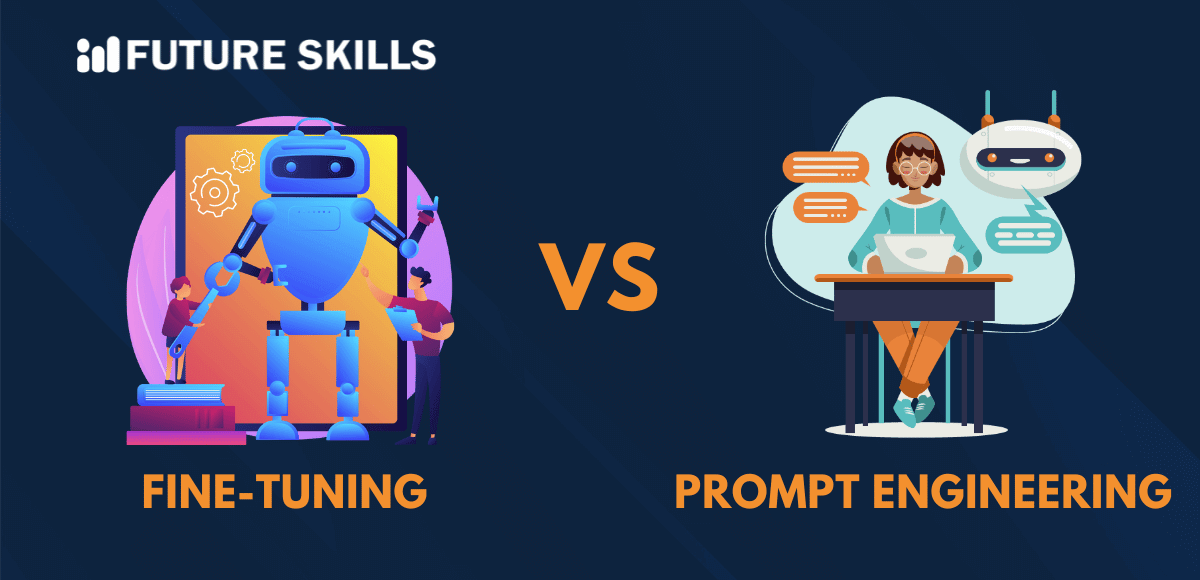The most common approach for improving the performance and reliability of LLMs involves breaking down the problems into smaller tasks. After identifying the smaller tasks, the LLM would receive a subtask as the prompt. Subsequently, the output generated for the prompt can serve as input for another prompt. Any prompt chaining guide would highlight this aspect as it defines the overall working mechanism of prompt chaining.
LLMs can be quite tricky to work with on certain occasions. Take a look at LLM examples to understand prompts for LLM better. The language models may not follow certain aspects of your prompts. In such cases, you have to look for proven and tested approaches for prompt chaining. Prompt chaining is a trusted prompting approach in the LLM landscape, recommended by model providers and the LLM community. Let us figure out what makes prompt chaining special and how it improves the prompting of LLMs for complex tasks.
Discover the power of Prompt Engineering by learning from experts with Certified Prompt Engineering Expert (CPEE)™ Certification.
Demystifying the Complexities around Prompt Chaining
Prompt chaining or chain prompting is a seemingly complex term that only AI experts or seasoned researchers could understand. However, prompt chaining is a crucial technique in the domain of large language models and conversational AI. The primary strength of prompt chaining focuses on improving the problem-solving power of artificial intelligence. In simple words, prompt chaining is the process of taking outputs from an AI system as the inputs for the next prompt. It would help develop a conversational relay that helps manage complex tasks in a step-by-step approach.
The prompt chaining process focuses on dividing complex problems into manageable smaller tasks. Specific prompts are used to manage and execute smaller tasks. Another crucial highlight in prompt chaining examples is the use of output from one prompt as input for next prompts. As a result, you will get a sequence of prompts leading to the final result. The primary goal of prompt chaining focuses on breaking down bigger problems into smaller, related tasks, thereby improving LLM performance.
How is Prompt Chaining Different from Other Prompting Techniques?
The use of advanced prompting techniques revolves around addressing complex problems. The responses to ‘What is chain prompting?’ can provide a superficial view of the way in which it works. On the other hand, you can develop a better understanding of prompt chaining with a comprehensive review of its unique functionalities.
Why do you need prompt chaining? You must have noticed that LLMs can end up with certain issues when they get detailed prompts as the inputs. LLMs work like librarians and are capable of handling categorized information. On the other hand, they are likely to face confusion when you ask them to work on a multi-genre thesis. In such cases, prompt chaining would come to the rescue. Here are some of the distinctive advantages of prompt chaining that make it the ideal alternative to other prompting techniques.
-
Prompt Chaining Addresses LLM Limitations
Prompt chaining can help in addressing the limitations of LLMs by serving as an effective tool to improve LLM functionalities. The review of any prompt chaining guide can help you understand how prompt chaining enables sequential simplification and reduces cognitive load on the LLM.
Division of a complex prompt into smaller prompts ensures that AI can process every segment with better accuracy. Breaking the larger problem into smaller tasks reduces the cognitive load on the LLM. In addition, the chained prompts help the AI model maintain a sharper focus on the concerned task for better responses.
-
Value of Layered Prompting
The layering of prompts in prompt chaining is also one of the prominent factors that drive its advantages. Each layer in the prompt chaining process adds depth to the understanding of the LLM. The layered prompting ensures improvements in contextual relevance, precision, and dynamic adaptability.
Every layer ensures coherence in the context, thereby ensuring that the LLM does not focus on irrelevant aspects. The impact of each response on the subsequent prompt ensures that LLMs can dynamically adapt to the evolving series of conversations. Furthermore, the chain of prompts also helps in improving the precision of responses.
-
An improvement over Chain-of-Thought Prompting
Prompt chaining also serves comprehensive advantages over traditional methods such as chain-of-thought prompting. You can use prompt chaining long-chain code to understand how it can offer better advantages than detailed, monolithic prompts. In the case of detailed prompts, LLMs might end up confused. On the other hand, prompt chaining serves as a strategic guide for the LLM through different steps. Prompt chaining offers the advantage of task decomposition alongside improving performance and reducing errors.
Prompt chaining not only breaks down a large problem into smaller tasks with specific focus points but also improves performance. The chances of error also decrease in each step of prompt chaining, thereby ensuring more reliable outputs.
-
Chain of Verification Prompting
Another important highlight of chain prompting is the chain of verification prompting, which provides better quality control benefits. It refers to the method in which data collected through the chain is subject to comprehensive review. All the steps in the chain provide valuable data to create a repository of information that would guide the final response.
The LLM would go through the collected data and refine the final answer before the final step. The final stage in the chain of verification prompting focuses on ensuring that the end result uses a solid foundation of verified data. It helps in improving confidence in the conclusions of the LLM.
Harness the power of AI and boost creativity and innovation through our Certified AI Professional (CAIP)™ Certification program.
Where is Prompt Chaining Useful?
The next crucial concern in a prompt chaining guide would refer to its use cases. What are the ideal situations in which you can use prompt chaining? The usability of prompt chaining is clearly evident when you have multi-step processes that require a combination of logic and creativity.
Prompt chaining elicits desired responses from LLMs by breaking down complex problems into different prompts. You can find a clear impression of the versatile applications of prompt chaining with real-world examples. The following list shows the tasks for which you can apply prompt chaining.
- Prompt chaining is a trusted technique for optimization of LLM performance in complex parallel tasks.
- Question-answering applications that use documents or facilitate interactions with documents can leverage prompt chaining.
- Data analysis problems can also utilize prompt chaining for importing datasets, cleaning and processing data, conducting analysis, and generating charts or graphs.
- Prompt chaining is also useful in cases where you have to write long-form content, such as stories or articles.
- You can also use prompt chaining for programming to perform tasks such as outlining program logic or debugging errors.
How Can You Use Langchain for Prompt Chaining?
You might wonder about the relevance of bringing Langchain into a discussion about prompt chaining. It is an open-source framework tailored to build applications by leveraging popular language models, such as GPT. The use of Langchain for advanced prompt engineering draws attention toward the prompt chaining Langchain relationship.
You can find a dedicated ‘Chain’ interface on Langchain that helps you use ‘Chains’ in Langchain. Another new method for prompt chaining involves the Langchain Expression Language or LCEL. However, the ‘Chain’ interface method is still one of the most preferred and useful methods for different types of projects.
How Can You Implement Prompt Chaining?
The review of different prompt chaining examples proves why it can serve as an effective solution to different problems. You can harness the power of prompt chaining by using the recommended best practices to refine AI output while ensuring the integrity of the system.
-
Task Definition and Subtask Identification
Prior to prompt chaining, you would have to understand the complexity of the problem. Therefore, you must begin with a clear definition of the task and the end goal. In addition, you must also break down the larger problem into smaller subtasks in a way that every subtask logically leads to the next and creates a coherent prompt chain.
-
Move from Simple to Complex
You can notice that all answers to “What is chain prompting?” focus on creation of simpler subtasks. Prompt chaining starts with a simple task that would work as the foundation for more complex processes. Subsequently, the LLM would demonstrate more proficiency in the simple tasks that would bring in more complex prompts. The unique stepwise approach creates a smoother learning curve for the LLM.
-
Continuous Evaluation and Security
Continuous evaluation is an important requirement for successful prompt chaining. You must have clear performance metrics to ensure that the subtasks follow the required standards. Furthermore, continuous monitoring and evaluation help in proactive identification of security threats and risk assessment. As a result, you can use the right safeguards against security risks, such as prompt injection.
Final Words
The advantages of prompt chaining prove its significance in the domain of prompt engineering. It is one of the trusted advanced prompting techniques that use multiple prompts to achieve answers for complex tasks. Any prompt chaining guide would highlight the importance of breaking down complex problems into smaller tasks.
At the same time, you must note that prompt chaining is different from chain-of-thought prompting in different ways. The diverse use cases of prompt chaining also prove that it is a powerful concept for LLMs. Discover more insights about prompt chaining with real-world examples right now.






